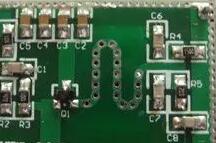Doppler radar is a type of radar that utilizes the Doppler effect to detect the position and relative velocity of moving targets.

Working principle of PCB Doppler radar
When a radar emits a fixed frequency pulse wave to scan the air, if encountering an active target, there is a frequency difference between the frequency of the echo and the frequency of the transmitted wave, which is called Doppler frequency. According to the magnitude of Doppler frequency, the radial relative motion velocity of the target to the radar can be measured; Based on the time difference between transmitting pulses and receiving, the distance of the target can be measured. At the same time, using the frequency filtering method to detect the Doppler frequency spectrum of the target and filter out the spectrum of interference clutter can enable the radar to distinguish the target signal from the strong clutter. So Doppler radar has stronger anti-clutter interference ability than ordinary radar and can detect moving targets hidden in the background.
Characteristics of PCB Doppler Radar
One difference between Doppler radar and traditional radar is that its transmitter is always on, and this type of radar is called continuous wave or CW radar. The reason why the transmitter must always be turned on is because, unlike traditional radar, it needs to calculate the time between transmission and reception, and Doppler radar looks for frequency changes. The frequency change will not last for a long time, so the transmitter must always be turned on.
Doppler radar has the following characteristics:
1) Adopting programmable signal processors to increase the processing capacity, speed, and flexibility of radar signals, improve the reusability of equipment, and enable radar to search while tracking, change or increase the working status of the radar. This enables the radar to have the ability to deal with various interferences and recognize targets beyond the line of sight;
2) Using programmable gate-controlled traveling wave tubes, the radar can operate at different pulse repetition rates, with the ability to adapt waveforms. It can select waveforms with low, medium, or high pulse repetition rates according to different tactical states, and can achieve the best performance in various working states;
3) Using Doppler beam sharpening technology to achieve high resolution, it can provide high-resolution map mapping and high-resolution local amplification mapping in air-to-ground applications. In air-to-air enemy situation judgment, dense formations of group targets can be distinguished.
The Role of PCB in Radar
The radar PCB board is a key component in the radar system, with important functions and functions.
1、 Design Principles
The design principle of the radar PCB board is based on the working principle of the radar system, which detects the position and velocity of target objects by receiving and sending electromagnetic waves. The radar PCB board needs to be designed according to the frequency, power, and operating mode requirements of the radar system to ensure stable signal transmission and accurate processing.
The design principles of radar PCB boards include antenna design, RF circuit design, and signal processing circuit design. Antenna design needs to consider factors such as antenna gain, directionality, and frequency response to achieve accurate detection of target objects. RF circuit design needs to consider signal amplification, filtering, and mixing functions to ensure signal strength and quality. The design of signal processing circuits needs to consider the calculation and display of parameters such as distance, speed, and direction of the target object, to provide accurate target information.
2、 Signal processing function
The radar PCB board has a signal processing function, which can process and analyze the received radar signals. Signal processing functions include signal filtering, target detection, parameter calculation, and data display.
Signal filtering is the process of denoising and enhancing the received radar signal to improve its quality and reliability. Target detection is the process of analyzing and judging the filtered signal to determine the presence and position of the target object. Parameter calculation is the calculation of parameters such as distance, velocity, and direction of the target object based on the received signal. Data display is the process of displaying the calculated target information in graphical or numerical form, making it convenient for users to observe and analyze.
3、 Performance requirements
The performance requirements of the radar PCB board directly affect the detection ability and accuracy of the radar system. The main performance requirements include frequency response, dynamic range, noise figure, and power consumption.
Frequency response refers to the signal transmission capability of the radar PCB board within the working frequency range, which requires a flat and stable frequency response. The dynamic range refers to the maximum and minimum signal strength range that the radar PCB board can handle, requiring a large and sensitive dynamic range. The noise figure refers to the impact of noise introduced by the radar PCB board on signal quality, requiring a low noise figure and high signal-to-noise ratio. Power consumption refers to the electrical energy consumed by the radar PCB board during operation, which requires low power consumption and high efficiency.
4、 Application field
Radar PCB boards are widely used in fields such as military, aviation, aerospace, transportation, meteorology, and security. In the military field, radar PCB boards are used for target detection, navigation, and communication, providing important tactical support. In the aviation and aerospace fields, radar PCB boards are used for aircraft navigation, obstacle avoidance, and target tracking to ensure flight safety. In the field of transportation and meteorology, radar PCB boards are used for monitoring and early warning of vehicles and weather, providing important traffic and meteorological information. In the field of security, radar PCB boards are used for intrusion detection, boundary monitoring, and target tracking to ensure security and prevention.
The PCB dollper radar, as an important component of the radar system, has various functions and functions such as design principles, signal processing functions, performance requirements, and application fields.